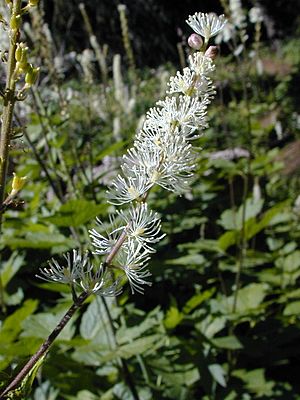Actaea elata facts for kids
Quick facts for kids Actaea elata |
|
|---|---|
 |
|
| Conservation status | |
| Scientific classification | |
| Genus: |
Actaea (plant)
|
| Species: |
elata
|
| Synonyms | |
|
|
Actaea elata, also known as tall bugbane, is a flowering plant. It belongs to the buttercup family. You can find it growing naturally in the Pacific Northwest region of North America. This includes British Columbia in Canada, and the states of Washington and Oregon in the USA. Its scientific name, Actaea elata, has a synonym which is Cimicifuga elata.
Contents
Discovering Tall Bugbane: What It Looks Like
This plant can grow quite tall, up to about 1.8 meters (almost 6 feet!). It's a perennial plant, meaning it lives for more than two years. It's also herbaceous, which means it has soft stems, not woody ones like a tree. It grows from a special underground stem called a rhizome.
Its stems and leaves are a bit hairy. Some of these hairs are 'glandular,' meaning they can produce sticky substances. The leaves are made up of many smaller parts called leaflets. These leaflets have rounded lobes and jagged edges, looking a bit like maple leaves.
Flowers and Fruit
The flowers grow in a tall, branching cluster called a panicle. This panicle can be up to 17 centimeters (about 7 inches) long. Each flower has five white or slightly pink sepals, which are like small leaves that protect the bud. Interestingly, these flowers do not have petals. Instead, they have many long, white stamens that stick out like a spray.
Tall bugbane blooms from May or June through August. After blooming, the plant produces a flat, dry fruit called a follicle. These fruits can be up to 1.2 centimeters long. It's important to know that the fruits are poisonous. The plant also has a smell that many people find unpleasant.
Where Tall Bugbane Lives: Its Habitat
This plant likes to grow in moist forests and woodlands. It is mostly found at lower elevations. It also prefers slopes that face north, as these areas tend to be shadier.
Forest Friends
Tall bugbane often grows near certain forest trees. These include Douglas fir (Pseudotsuga menziesii), bigleaf maple (Acer macrophyllum), western redcedar (Thuja plicata), red alder (Alnus rubra), and vine maple (Acer circinatum). Other plants that share its home are oceanspray (Holodiscus discolor), hazelnut (Corylus cornuta), sword fern (Polystichum munitum), and snowberry (Symphoricarpos albus).
Some plants are called indicator species because they often grow where tall bugbane is found. These include Alpine enchanter's nightshade (Circaea alpina), herb robert (Geranium robertianum), and wall lettuce (Lactuca muralis).
Forest Conditions
Where tall bugbane is common, it can cover a large part of the forest floor. It is often found in old-growth forests, which are very old and undisturbed forests. This plant prefers the shade of dense forests. It can handle some small gaps in the tree canopy. However, it does not do well with large clearings, like those made by clearcutting (when all trees in an area are cut down). A little sunlight reaching the plant during its growing season can be helpful for it to reproduce.
Animals like the mountain beaver (Aplodontia rufa) are sometimes found near tall bugbane, especially in Canada. Depending on the area, different pollinators help the plant reproduce. These can include bumblebees, other types of bees, beetles, and syrphid flies.
Where Tall Bugbane Is Found: Its Distribution
This plant has a limited range where it grows. Most of its populations are in southern Oregon, and these groups of plants can be quite large. There are fewer places where it grows in Washington state.
In British Columbia, Canada, tall bugbane is only found in the very southern parts of the province. It grows near the Chilliwack River. Because it is so rare there, it is considered an endangered species in British Columbia. There are only ten known groups of these plants in British Columbia. These make up less than 5% of all the tall bugbane plants in the world.
New Discoveries
In 2004, a new type, or variety, of this species was identified. It was named var. alpestris. This variety is only found in southern Oregon. It is different because it has scales on its lower stem. It also often has more pistils, which are the parts of the flower that produce seeds. This variety may also be found at higher elevations.
Protecting Tall Bugbane: Threats to the Plant
Tall bugbane faces dangers from things that threaten its forest homes. These include activities that harm old-growth forests in the Pacific Northwest.
Threats to the plant include:
- Fire suppression: Efforts to stop natural forest fires can change the forest environment.
- Logging: Cutting down trees, especially large-scale logging, removes the shade the plant needs.
- Road maintenance: Building and maintaining roads can disturb its habitat.
- Forest disturbance: Other activities that disrupt the forest can harm the plant.
- Wild collection: People collecting the plant from its natural environment can reduce its numbers.
- Pollinator damage: If the insects that pollinate the plant are harmed, the plant cannot reproduce as well.
All these factors can reduce the number of tall bugbane plants.


